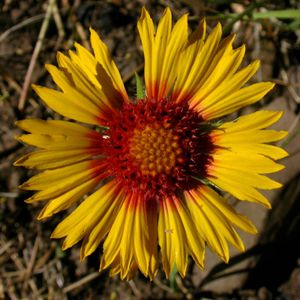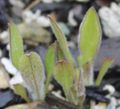Difference between revisions of "Gaillardia aristata"
m (Tag: VisualEditor) |
|||
| (6 intermediate revisions by 2 users not shown) | |||
| Line 1: | Line 1: | ||
| − | * | + | * Scientific Name: ''Gaillardia'' ''aristata'' |
* Family: Asteraceae | * Family: Asteraceae | ||
* Common Names: blanket flower, great flowered gaillardia | * Common Names: blanket flower, great flowered gaillardia | ||
* Codon: GALARI | * Codon: GALARI | ||
| − | ==Taxonomy== | + | ---- |
| − | == | + | [[File:GAIARI8.jpg |thumb|Photo by Ben Legler, 2004, also featured on Main Page]] |
| − | + | ===Taxonomy=== | |
| + | {{Taxobox | ||
| + | | name = | ||
| + | | image = | ||
| + | | image_alt = Achillea millefolium | ||
| + | | image_caption = Photo by Ben Legler, 2004. Featured on Main Page | ||
| + | | regnum = [[Plant]]ae | ||
| + | | subregnum = Viridiplantae | ||
| + | | phylum = Tracheophyta | ||
| + | | subphylum= Spermatophytina | ||
| + | | classis = Magnoliopsida | ||
| + | | subclassis = Asteridae | ||
| + | | ordo = Asterales | ||
| + | | familia = Asteraceae | ||
| + | | genus = ''Gaillaridia'' Foug. | ||
| + | | species = '''''Gaillardia aristata''''' Pursh | ||
| + | | binomial = | ||
| + | | binomial_authority = | ||
| + | | synonyms = | ||
| + | | range_map = | ||
| + | | range_map_alt = | ||
| + | | range_map_caption = | ||
| + | }} | ||
| + | <ref>Integrated Taxonomic Information System. Retrieved from https://www.itis.gov/servlet/SingleRpt/SingleRpt?search_topic=TSN&search_value=37398</ref> | ||
| − | + | ===Description=== | |
| + | Native, herbaceous taprooted perennial, with one or several stems rising from the base.<ref name=":0">Winslow, S., 2011. Plant Guide for blanketflower (Gaillardia aristata). USDA-Natural Resources Conservation Service, Plant Materials Center. Bridger, Montana 59014.</ref> 1-3 dms tall.<ref name=":1">Winslow, S. 2011. Plant fact sheet for blanketflower (Gaillardia aristata). USDA-Natural Resources Conservation Service, Plant Materials Center. Bridger, MT, 59014.</ref> | ||
| − | + | Leaves are alternate, rough-hairy, lance-shaped, entired to lobed, rarely pinnately divided.<ref name=":0" /> | |
| + | |||
| + | Capitate inflorescence bearing yellow rays, often maroon at base, 1.5-3.5 cm. long, disk corollas purplish. Receptacle concex to subglobose, with chaffy bristles that do not subtend the individual florets. <ref>Hitchcock, C. L., Cronquist, A., Giblin, D., & Legler, | ||
| + | B. et al. (2018). ''Flora of the Pacific Northwest: an illustrated manual''. | ||
| + | Seattle: University of Washington Press.</ref> | ||
| + | |||
| + | ''Aristata'' derived from Latin ''arist,'' bristle, in reference to the hairy stems and leaves, and the bristled fruits.<ref name=":0" /> | ||
| + | |||
| + | Fruit is a one-seeded, gray-brown achene, 7-10mm inch long, with densely ascending hairs, a short pappus crown 7-10mm long, and awns approximately two times as long as the fruit body.<ref name=":0" /> | ||
==Bloom Period== | ==Bloom Period== | ||
| − | May - September | + | May - September<ref>WTU Herbarium, Burke Museum, |
| − | ==Distribution== | + | & University of Washington. Retrieved from <nowiki>https://biology.burke.washington.edu/herbarium/imagecollection/taxon.php?Taxon=Gaillardia%20aristata</nowiki></ref> |
| − | + | ===Distribution=== | |
| − | ==Habitat== | + | From south-central Canada to southern Colorado, east to the Dakotas and west to the Cascade Mountains of Washington and the Blue Mountains of Oregon.<ref name=":0" /> |
| − | + | ===Habitat=== | |
| − | + | Sunny, well-drained sites in prairie meadows up to montane grassy openings.<ref name=":1" /> | |
| + | |||
| + | ===Uses=== | ||
| + | |||
| + | ==== Medicine and Food ==== | ||
| + | A rich array of medicinal uses, including but not limited to the following | ||
| + | |||
| + | Sx̌ʷyʔiɬpx use of whole plant decoction as a tonic for kidney ailments, poultice of plant applied for backaches, decoction of plant for headaches.<ref>Native American Ethnobotany Database. Retrieved from <nowiki>http://naeb.brit.org/uses/search/?string=gaillardia+</nowiki></ref> | ||
| + | |||
| + | Nlaka'pamux use of infusion of whole plant as a treatment for cancer. <ref name=":2">Turner, Nancy J., Laurence C. Thompson and M. Terry Thompson et al., | ||
| + | 1990, Thompson Ethnobotany: Knowledge and Usage of Plants by the | ||
| + | Thompson Indians of British Columbia, Victoria. Royal British Columbia | ||
| + | Museum, page 181. Retrieved from http://naeb.brit.org/uses/search/?string=gaillardia+</ref> It is important to note that depending on the time of the source and the orientation of the researcher, the term 'cancer' in medical and ethnobotanical texts may refer to a variety of conditions, that may or may not overlap neatly with common contemporary usage of the word. | ||
| + | |||
| + | Nlaka'pamux use of decoction of plant as a tuberculosis remedy.<ref name=":2" /> | ||
| + | |||
| + | Havsuw' Baaja use as food, seeds parched, ground, and kneaded into seed butter.<ref>Weber, Steven A. and P. David Seaman, 1985, Havasupai Habitat: A. F. | ||
| + | Whiting's Ethnography of a Traditional Indian Culture, Tucson. The | ||
| + | University of Arizona Press, page 67. Retrieved from http://naeb.brit.org/uses/search/?string=gaillardia+</ref> | ||
| + | |||
| + | A rash or irritation may result from contact with the sap.<ref name=":1" /> | ||
| + | |||
| + | ==== Ecological ==== | ||
| + | ''G. aristata'' can be used in producing native wildflower sod for restoration of native plant colonies.<ref name=":0" /> | ||
| + | |||
| + | Provides food source of pollen, nectar, and cover for a wide variety of pollinators. It is a common nectar source for the adult stage of the butterfly, Edwards fritillary, ''Speyeria edwards''. <ref name=":0" /> | ||
| + | |||
| + | A cryptic moth, ''Schinia masoni,'' is color-camouflaged to mimic the yellow ray flowers and purplish-brown disk flowers of blanketflower as protection against predators.<ref name=":0" /> | ||
| − | + | Forage for young sage-grouse.<ref name=":0" /> | |
| − | + | ||
| − | + | ||
| − | + | ||
| − | = | + | Competes well with certain noxious weeds such as ''Acroptilon repens.''<ref name=":0" /> |
| − | + | ||
| − | + | ||
| − | + | ===Propagation=== | |
| − | + | Tolerant of drought conditions, and relatively fire resistant.<ref name=":0" /> | |
| − | + | May be grown from seed or crown division. Spring seeding is preferred over summer or fall dormant seeding. Stratification is not necessary, but a period of cold moist stratification may decrease germination variability. The plants tend to be rather long-lived and may re-seed once established. <ref name=":1" /> | |
| − | + | ||
| − | ==Photo Gallery== | + | ===Photo Gallery=== |
<gallery> | <gallery> | ||
File:GAIARI2.jpg| Photo by Rod Gilbert, 2005. | File:GAIARI2.jpg| Photo by Rod Gilbert, 2005. | ||
| Line 42: | Line 95: | ||
</gallery> | </gallery> | ||
| − | ==References== | + | ===References=== |
Latest revision as of 21:57, 20 March 2021
- Scientific Name: Gaillardia aristata
- Family: Asteraceae
- Common Names: blanket flower, great flowered gaillardia
- Codon: GALARI
Contents
Taxonomy
| Scientific classification | |
|---|---|
| Kingdom: | Plantae |
| Subkingdom: | Viridiplantae |
| Phylum: | Tracheophyta |
| Subphylum: | Spermatophytina |
| Class: | Magnoliopsida |
| Subclass: | Asteridae |
| Order: | Asterales |
| Family: | Asteraceae |
| Genus: | Gaillaridia Foug. |
| Species: | Gaillardia aristata Pursh |
Description
Native, herbaceous taprooted perennial, with one or several stems rising from the base.[2] 1-3 dms tall.[3]
Leaves are alternate, rough-hairy, lance-shaped, entired to lobed, rarely pinnately divided.[2]
Capitate inflorescence bearing yellow rays, often maroon at base, 1.5-3.5 cm. long, disk corollas purplish. Receptacle concex to subglobose, with chaffy bristles that do not subtend the individual florets. [4]
Aristata derived from Latin arist, bristle, in reference to the hairy stems and leaves, and the bristled fruits.[2]
Fruit is a one-seeded, gray-brown achene, 7-10mm inch long, with densely ascending hairs, a short pappus crown 7-10mm long, and awns approximately two times as long as the fruit body.[2]
Bloom Period
May - September[5]
Distribution
From south-central Canada to southern Colorado, east to the Dakotas and west to the Cascade Mountains of Washington and the Blue Mountains of Oregon.[2]
Habitat
Sunny, well-drained sites in prairie meadows up to montane grassy openings.[3]
Uses
Medicine and Food
A rich array of medicinal uses, including but not limited to the following
Sx̌ʷyʔiɬpx use of whole plant decoction as a tonic for kidney ailments, poultice of plant applied for backaches, decoction of plant for headaches.[6]
Nlaka'pamux use of infusion of whole plant as a treatment for cancer. [7] It is important to note that depending on the time of the source and the orientation of the researcher, the term 'cancer' in medical and ethnobotanical texts may refer to a variety of conditions, that may or may not overlap neatly with common contemporary usage of the word.
Nlaka'pamux use of decoction of plant as a tuberculosis remedy.[7]
Havsuw' Baaja use as food, seeds parched, ground, and kneaded into seed butter.[8]
A rash or irritation may result from contact with the sap.[3]
Ecological
G. aristata can be used in producing native wildflower sod for restoration of native plant colonies.[2]
Provides food source of pollen, nectar, and cover for a wide variety of pollinators. It is a common nectar source for the adult stage of the butterfly, Edwards fritillary, Speyeria edwards. [2]
A cryptic moth, Schinia masoni, is color-camouflaged to mimic the yellow ray flowers and purplish-brown disk flowers of blanketflower as protection against predators.[2]
Forage for young sage-grouse.[2]
Competes well with certain noxious weeds such as Acroptilon repens.[2]
Propagation
Tolerant of drought conditions, and relatively fire resistant.[2]
May be grown from seed or crown division. Spring seeding is preferred over summer or fall dormant seeding. Stratification is not necessary, but a period of cold moist stratification may decrease germination variability. The plants tend to be rather long-lived and may re-seed once established. [3]
Photo Gallery
References
- ↑ Integrated Taxonomic Information System. Retrieved from https://www.itis.gov/servlet/SingleRpt/SingleRpt?search_topic=TSN&search_value=37398
- ↑ 2.00 2.01 2.02 2.03 2.04 2.05 2.06 2.07 2.08 2.09 2.10 Winslow, S., 2011. Plant Guide for blanketflower (Gaillardia aristata). USDA-Natural Resources Conservation Service, Plant Materials Center. Bridger, Montana 59014.
- ↑ 3.0 3.1 3.2 3.3 Winslow, S. 2011. Plant fact sheet for blanketflower (Gaillardia aristata). USDA-Natural Resources Conservation Service, Plant Materials Center. Bridger, MT, 59014.
- ↑ Hitchcock, C. L., Cronquist, A., Giblin, D., & Legler, B. et al. (2018). Flora of the Pacific Northwest: an illustrated manual. Seattle: University of Washington Press.
- ↑ WTU Herbarium, Burke Museum, & University of Washington. Retrieved from https://biology.burke.washington.edu/herbarium/imagecollection/taxon.php?Taxon=Gaillardia%20aristata
- ↑ Native American Ethnobotany Database. Retrieved from http://naeb.brit.org/uses/search/?string=gaillardia+
- ↑ 7.0 7.1 Turner, Nancy J., Laurence C. Thompson and M. Terry Thompson et al., 1990, Thompson Ethnobotany: Knowledge and Usage of Plants by the Thompson Indians of British Columbia, Victoria. Royal British Columbia Museum, page 181. Retrieved from http://naeb.brit.org/uses/search/?string=gaillardia+
- ↑ Weber, Steven A. and P. David Seaman, 1985, Havasupai Habitat: A. F. Whiting's Ethnography of a Traditional Indian Culture, Tucson. The University of Arizona Press, page 67. Retrieved from http://naeb.brit.org/uses/search/?string=gaillardia+






